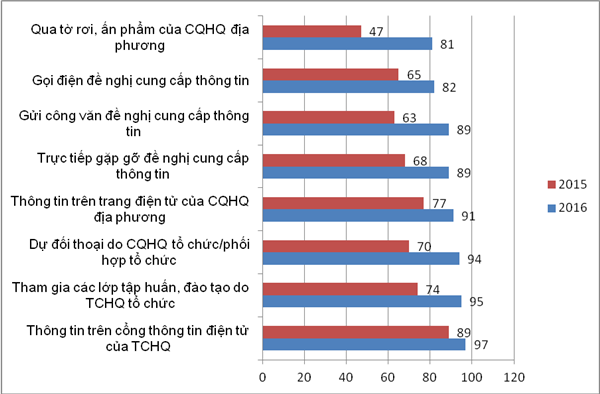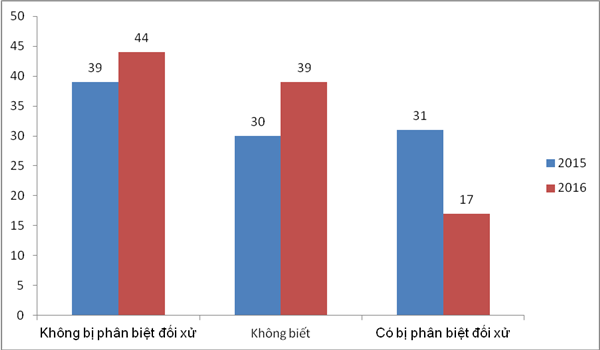The difference of customs reform index in 2016 compare to 2015?
| Customs administrative reform: Many indicators continue to be improved | |
| Vietnam supports UN reform efforts | |
| Customs issued an Action Plan to implement Resolution 19/2017 |

Percentage of satisfied/fully satisfied enterprises regarding the method of information inquiry about Customs administrative formalities 2015-2016.
This is the information released at the workshop on "Assessment of Customs administrative formalities: Enterprise Satisfaction in 2016" recently organised by VCCI in cooperation with the General Department of Customs.
Specifically, in terms of an indicator of accessing to information on customs and customs administrative formalities, all 8 approaches to information on customs administrative formalities in 2016 have a satisfaction/completely satisfaction percentage higher than 2015. For example, if in 2015, access to information on customs and customs administrative formalities in the context of dialogue held by the customs authorities only reached 74% of satisfied/completely satisfied enterprises, this index reached 94% in 2016; In case of official proposal to provide information in 2016, 89% of the enterprises are satisfied/completely satisfied, this index is 62% in 2015.
In addition, the enterprise also highly appreciates the information of customs administrative formalities that enterprises have access as: Easy Forms of Customs formalities; The information provided by the customs are consistent; The Information on customs administrative formalities are available and easy to find; Customs offices provide information quickly and up to date; The information on customs administrative formalities are simple and easy to understand. Specifically, in 2016, the number of enterprises evaluate the simplified customs administration forms was 87%, 77% in 2015; The number of enterprises evaluates the information on customs administrative formalities easy to understand was 74%, 65% in 2015.
Regarding the implementation of customs administrative formalities, the majority of enterprises have thought that implementing customs administrative formalities is not too difficult, just at the normal level. The procedure for paying taxes is the highest rate, 29%, followed by the inspection (12%). However, some procedures that have been assessed by enterprises are difficult to implement relatively high; tax refund procedures (29%), tax exemption procedures 26%, complaints settlement (21%). Comparing the proportion of enterprises experiencing difficulties in implementing administrative procedures in the two years 2015-2016, some areas and the ratio of enterprises experiencing difficulties have decreased compared to 2015 including: Verification of customs documents, physical inspection of, tax exemption, tax refund procedures, non-collection of tax.
In the case of difficulties in implementing the administrative formalities, enterprises have asked the customs office to support, 84% of the enterprise's evaluation are fully effective, only 15% less effective and 1% ineffective. Among the enterprise, FDI evaluated the best efficiency for the support from customs. (87%)
However, besides the indicators of customs administrative formalities are highly appreciated by enterprises, there are still indicators have not improved. For example, the assessment of the service provided by customs officers, the degree of the disciplinary conduct of customs officers in 2016 has not improved compared to 2015. There is only an indicator of evaluation civil servants' civilised, politically in term of communication slightly higher than in 2015 (+ 2%). Meanwhile, 31% of respondents said that they paid unofficial fees during the implementation of customs formalities, 31% did not know and 38% did not.
 |
In the case of non-payment of unofficial fees, if the enterprises are discriminated? The survey found that 44% of enterprises said they were not discriminated, 17% were discriminated and 39% did not know. Compared with 2015, the above results show positive developments. Most notably, the rate of Discriminated Enterprises dropped sharply from 31% in 2015 to 17% in 2016. The proportion of enterprises did not pay and non-discriminatory enterprises increased from 39% in 2015 to 44% 2016.
Deputy Director-General of the General Department of Customs, Vu Ngoc Anh, noted that according to VCCI's survey, most of the reforms in the customs reforms were changed, however. There are some areas are going back. Thereby, besides administrative formalities, it also related to the duty of customs officers, the information approach to the enterprise. The issue of subordinate implementation, the inconsistent implementation of the subordinate stills exists. Therefore, according to Deputy Director General Vu Ngoc Anh, to overcome the outstanding issues, the customs has been implementing a number of specific solutions such as: Continue to standardise legislations which are simple, transparent, easy to implement; Focus on training and discipline of customs civil servants, and there are penalties for dealing with misleading regulations.
 | Customs increase to settle administrative formalities online VCN – This is an important requirement of the Ministry of Finance to direct their units and ... |
In addition, Deputy Director General Vu Ngoc Anh said that customs will continue to promote the application of information technology in the customs formalities, applying modern risk management methods. Implementing enterprise management in accordance with risk assessment criteria, large enterprises comply with good law enforcement will have priority management regime, facilitate the implementation of customs procedures. In addition, in the coming time, customs will also focus on training and legal support to small and medium enterprises in the implementation of customs administrative formalities. Because this is targeted vulnerable enterprises when implementing the provisions of law.
Related News

Customs sector achieves outstanding results in customs reform
10:09 | 28/03/2023 Customs

Reform the tax debt management process
14:12 | 20/03/2023 Customs

What are the proposals from enterprises about administrative procedure reform?
15:06 | 27/02/2023 Customs

Reforming training work to meet modern customs management model
13:55 | 22/02/2023 Customs
Latest News

Customs creates maximum facilitation for agricultural exports
15:56 | 07/06/2023 Customs

Goods imported from export processing enterprises must pay tax
14:50 | 10/04/2023 Customs

GDVC perform tasks in second quarter of 2023
09:47 | 06/04/2023 Customs

Facilitates import and export enterprises amid difficult context
09:46 | 06/04/2023 Customs
More News

Da Nang International Terminal a certified 4-star terminal
10:24 | 05/04/2023 Customs

Dong Nai Customs: understand the business situation to develop effective support solutions
13:27 | 04/04/2023 Customs

Lang Son: Import-export turnover grow 71%
09:53 | 03/04/2023 Customs

HCM City Customs Department facilitates and resolves difficulties for enterprises
09:51 | 03/04/2023 Customs

Lang Son: Goods rushing to border gate increases sharply, potential risk of congestion
10:33 | 02/04/2023 Customs

Bac Ninh Customs committees to listen and share difficulties with enterprises
20:34 | 01/04/2023 Customs

Ho Chi Minh City Customs removes obstacles for logistics businesses
20:33 | 01/04/2023 Customs

Bac Ninh Customs considers satisfaction of businesses to assess efficiency of customs reform
11:36 | 01/04/2023 Customs

HCM City Customs make efforts in budget collection
13:43 | 31/03/2023 Customs
Your care
The system has not recorded your reading habits.
Please Login/Register so that the system can provide articles according to your reading needs.

Customs creates maximum facilitation for agricultural exports
15:56 | 07/06/2023 Customs

Goods imported from export processing enterprises must pay tax
14:50 | 10/04/2023 Customs

GDVC perform tasks in second quarter of 2023
09:47 | 06/04/2023 Customs

Facilitates import and export enterprises amid difficult context
09:46 | 06/04/2023 Customs

Da Nang International Terminal a certified 4-star terminal
10:24 | 05/04/2023 Customs
